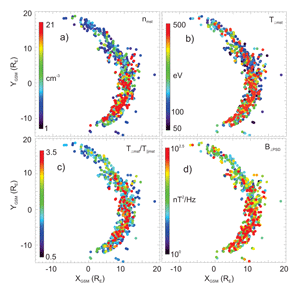
2013 THEMIS SCIENCE NUGGETS
Heating of the magnetosheath due to wave-particle interactions
Chris Chaston, School of Physics University of Sydney;
and Space Sciences Laboratory University of California at Berkeley
Introduction
The shocked solar wind plasmas of the Earth’s magnetosheath provide a major source for plasmas of the magnetosphere [Hultqvist and Oieroset, 1998]. While it is well appreciated that the transition of solar wind plasmas through the bow shock drive non-adiabatic changes in ion distributions; it is perhaps not so well appreciated that significant processing of these distributions occurs within the magnetosheath and in the boundary layers of the magnetosphere itself. In a recent study Chaston et al., [2013] used THEMIS observations through the Earth’s magnetosheath and across the magnetopause to explore the role that fluctuations in electric and magnetic fields play in modifying the properties of magnetosheath plasmas.
| Figure 1. Wave and particle survey results through Earth’s dayside magnetosheath and magnetopause. Each dot corresponds to a wave event with the color defined as shown by the color bar on each panel. a) shows the density of magnetosheath ions, b) shows the temperature of magnetosheath ions measured in the direction perpendicular to the back ground magnetic field (T⊥), c) shows the ion anisotropy defined as the ratio T⊥/T∥ and d) shows the spectral energy density of the magnetic field fluctuations. |
Results
Figure 1 shows results from a survey of wave and particle properties through the magnetosheath. These results are plotted on a spatial grid looking downward from the North Pole with the Sun to the right. Here the colored dotted region corresponds to that portion of the magnetosheath traversed by the THEMIS spacecraft and where large amplitude fluctuations in electric and magnetic field where observed. Significantly, the occurrence of enhanced wave activity (d) is correlated with enhanced ion density (a), temperature (b), and anisotropy (c) defined by the ratio of the ion temperature measured perpendicular and parallel to the large scale magnetic field. It was shown in Chaston et al. [2013] that once adiabatic changes were removed not only was the location of enhanced ion temperature correlated with the occurrence of wave activity but that the temperature observed was very closely related to the observed wave energy. These authors demonstrated that this correlation/variation could be explained due to ion scattering in the wave-fields leading to heating.
Discussion
The occurrence of heating in the magnetosheath has profound implications for the plasmas of the magnetosphere. Since these plasmas cross the magnetopause to populate the magnetosphere, the degree of heating they experience alters the distribution of entropy. This can predispose the magnetosphere to instability leading to substorms. Further study is required to trace the path that these heated ions follow within the magnetosphere to fully appreciate the role they could play in magnetospheric dynamics.
Reference
Chaston, C. C., Y. Yao, N. Lin, C. Salem, and G. Ueno (2013), Ion heating by broadband electromagnetic waves in the magnetosheath and across the magnetopause, J. Geophys. Res. Space Physics, 118, doi:10.1002/jgra.50506.Hultqvist, B., and M. Oieroset (Eds) (1998), Transport Across the Boundaries of the Magnetosphere, Space Sci. Rev., 85(3-4), 553.
Biographical Note
Chris Chaston is an Associate Professor in the School of Physics at the University of Sydney Australia and a Research Physicist at the University of California at Berkeley USA.
 Please send comments/suggestions to
Emmanuel Masongsong / emasongsong @ igpp.ucla.edu
Please send comments/suggestions to
Emmanuel Masongsong / emasongsong @ igpp.ucla.edu

